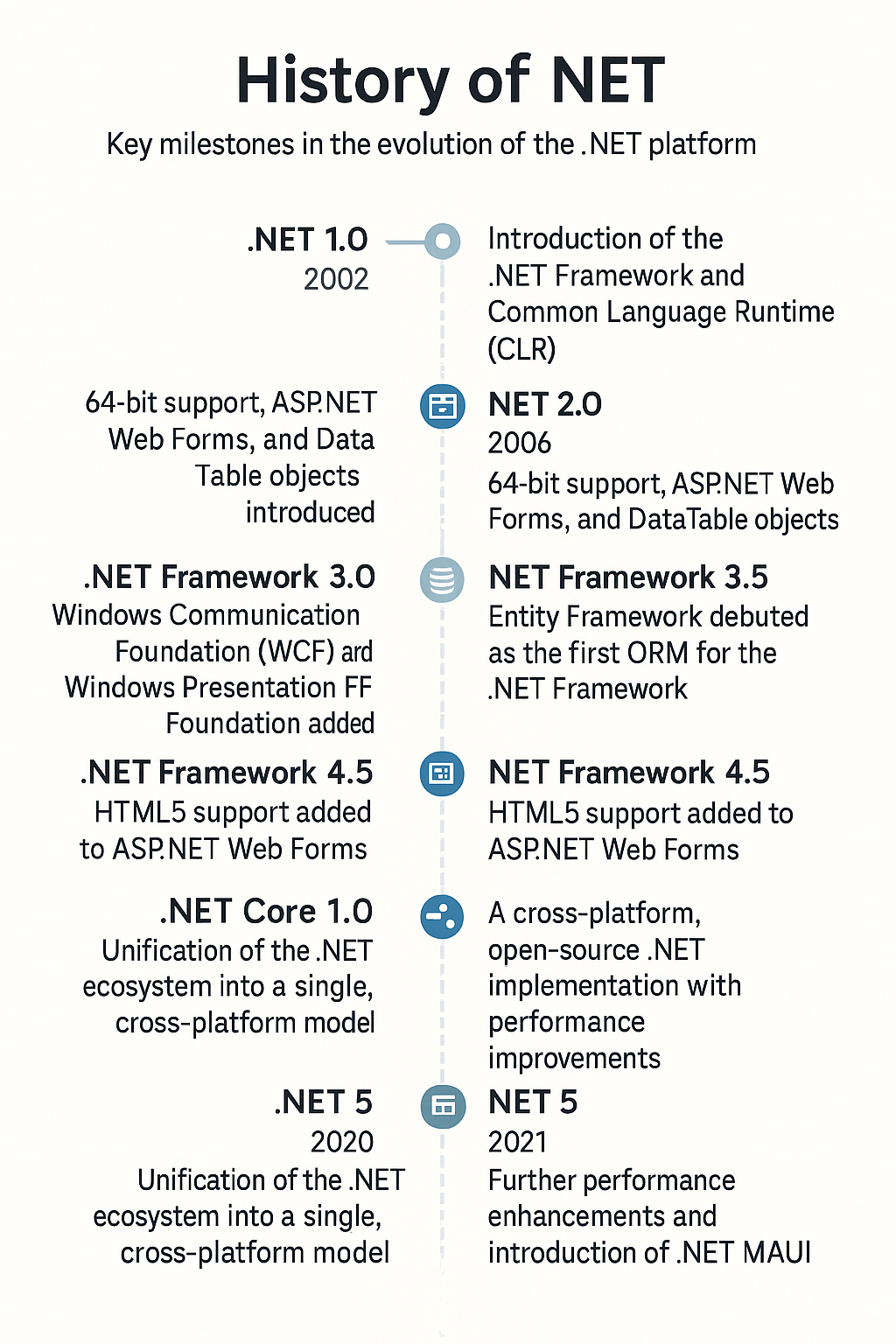
History of .NET
The .NET platform wasn't always the versatile, cross-platform framework we know today. It started in the early 2000s, in a world dominated by Java and PHP. Microsoft needed a powerful development environment to compete in the enterprise space and this is how .NET began its journey.
🏗️ Early Foundations: .NET Framework 1.0 to 2.0
In 2000, the beta version of .NET was introduced. The official 1.0 release followed in 2002, supporting Windows 98, ME and XP. Its key innovation was the Common Language Runtime (CLR), which allowed developers to use multiple programming languages like C# and VB in the same solution.
This language interoperability made it easier to reuse code, though the framework was still limited to Windows environments.
By 2003, .NET 1.1 introduced support for Open Database Connectivity (ODBC), aligning with emerging enterprise needs. But the platform still lacked mainstream adoption and needed major improvements.
In 2006, .NET Framework 2.0 launched with Visual Studio 2005, introducing 64-bit support, partial classes in C#, new ASP.NET authentication options and in-memory data operations with DataTable objects. This marked a shift toward serious enterprise application development.
🧱 Web Forms and Visual Studio Integration
ASP.NET Web Forms gained popularity due to its familiarity for desktop developers. Visual Studio made building web apps accessible with drag-and-drop UI components, bridging the gap between desktop and web development.
Web Forms introduced ViewState to preserve server-side state between requests and allowed code-behind separation between HTML and logic, which was innovative at the time.
🛰️ Web Services Era: WCF and Desktop Innovations
.NET Framework 3.0 arrived in 2006 with major additions like Windows Communication Foundation (WCF) and Windows Presentation Foundation (WPF). WCF made integrating external web services easier using Visual Studio tools. Developers could auto-generate C# classes and methods from service URLs, simplifying third-party integrations.
WPF introduced a new desktop UI model using XAML and 3D graphics, offering a modern alternative to Windows Forms.
🗃️ ORM and Performance: Framework 3.5 to 4.5
.NET Framework 3.5 (2007) introduced Entity Framework, Microsoft’s answer to object-relational mapping. Though the initial release had issues, the 2008 Service Pack brought critical fixes that improved adoption.
.NET Framework 4.0 (2010) focused on stability. Then in 2012, version 4.5 introduced HTML5 support in Web Forms, WebSocket protocol and asynchronous HTTP operations, aligning with modern web standards.
🧩 Final Framework Milestones Before .NET Core
In 2015, .NET Framework 4.6 became the last major version before Microsoft pivoted to .NET Core. It introduced support for Azure SQL distributed transactions and localization tools for ASP.NET apps. Versions 4.7 and 4.8 followed but the future of .NET was moving in a new direction.
🌍 Cross-Platform Revolution: .NET Core
By 2015, the demand for cross-platform development was undeniable. Microsoft answered by releasing .NET Core 1.0 in 2016. This was a clean break: new libraries, a new runtime and complete support for Linux and macOS. ASP.NET and Entity Framework were rebranded as ASP.NET Core and EF Core.
.NET Core was also fully open-source, hosted on GitHub. The developer community could now report bugs, suggest features and even contribute code. This openness attracted many developers from other ecosystems.
📦 .NET Standard: Bridging the Versions
To enable compatibility across different .NET platforms, Microsoft introduced .NET Standard. This defined a common API surface, allowing shared libraries to work with .NET Framework, .NET Core, Xamarin and others.
Developers could migrate apps gradually by building .NET Standard libraries, ensuring backward compatibility and future readiness.
🚀 The Modern Era: .NET 5+
In 2020, Microsoft released .NET 5, the unification of .NET Core and .NET Framework. It signalled the start of a single, cross-platform .NET ecosystem.
.NET 6 (2021) brought massive performance boosts, ARM64 support, C# 10, HTTP/3, MAUI for native apps and new project templates. .NET 7 (2022) continued this trend, refining the developer experience and adding cloud-native features.
Today, .NET powers apps across web, desktop, cloud, mobile, gaming, IoT and AI. Its journey from Windows-only to a unified platform is one of the most significant transformations in modern software development.